Here for the first time is the complete history of Hitler's empire. No other empire ever bequeathed to historians such mountains of evidence about its rise and fall as the Third Reich. The Allied demand for unconditional surrender produced - before the Nazis could destroy their files - an almost hour-to-hour record of the nightmare realm created by Hitler. This record includes the testimony of Nazi leaders, concentration camp inmates, the diaries of officials, transcripts of secret conferences, army orders, private letters - all the vast paper work behind a conspiracy to conquer the world. This is also the story of Hitler the man - his love affairs, his imprisonment, his suicide. There is also details of the plot to kidnap the Duke and Duchess of Windsor and hundreds of other inside stories. Most of all, it is the story of how Hitler destroyed his beloved Germany. The author, who watched and reported on the Nazis since 1925 had been reporting on-the-spot from Germany and Europe for almost forty years and spent over five years sifting the mountains of paper that eventually became this definitive history.
- Sorry, this product is unavailable.
-
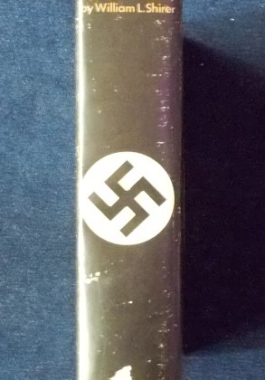
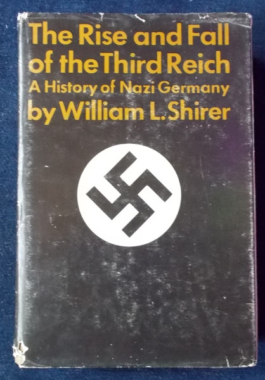
-
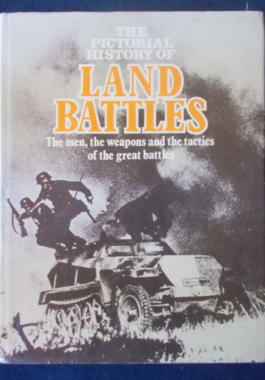 A book full of information, pictures and maps of land battles throughout history that proves it was not always about who had the biggest army. In this volume - Metaurus - after the toughest forced march in history, Nero slays Hasdrubal; Agincourt - massed archers and infantry slaughter the French cavalry; Bunker Hill - a thousand farmers ignite the flame of American independence; Austerlitz - Napoleon crushes an army bigger than his own; Balaclava - a battle of idiocy and sheer courage; Second Bull Run - a high spot for the South in the American Civil War; The Somme - slaughter on a scale never seen before or since; Cambrai - tanks explode into action for the first time; Gazala - Rommels' fast moving tactical brilliance; Stalingrad - Hitler's obstinacy leads the Wehrmacht to disaster; Cassino and Anzio - Allied forces combine to force a breakthrough; The Battle Of The Bulge - fast moving Panzers against Eisenhower, Montgomery and Patton; Operation Commando - a true 'United Nations; against the Chinese in Korea. Illustrated with archival photographs, artists' representations and maps.
A book full of information, pictures and maps of land battles throughout history that proves it was not always about who had the biggest army. In this volume - Metaurus - after the toughest forced march in history, Nero slays Hasdrubal; Agincourt - massed archers and infantry slaughter the French cavalry; Bunker Hill - a thousand farmers ignite the flame of American independence; Austerlitz - Napoleon crushes an army bigger than his own; Balaclava - a battle of idiocy and sheer courage; Second Bull Run - a high spot for the South in the American Civil War; The Somme - slaughter on a scale never seen before or since; Cambrai - tanks explode into action for the first time; Gazala - Rommels' fast moving tactical brilliance; Stalingrad - Hitler's obstinacy leads the Wehrmacht to disaster; Cassino and Anzio - Allied forces combine to force a breakthrough; The Battle Of The Bulge - fast moving Panzers against Eisenhower, Montgomery and Patton; Operation Commando - a true 'United Nations; against the Chinese in Korea. Illustrated with archival photographs, artists' representations and maps. -
 A volume of military activity, weaponry and technology from 1987. Arenas of activity covered: The Middle East - Tripoli; Lebanon; the Gulf War; South Yemen and the Arab-Israeli conflict. Europe, North America and the Soviet Union: Terrorism and Power Politics; The Superpower Relationship; NATO and the Warsaw Pact; International Terror; Northern Ireland. Asia - Islam's Guerrillas; The Tamil Tigers; The Philippines; Vietnam and Cambodia' Sikh Separatists. Africa - South Africa; Mozambique; Angola; Chad; The Sudan; Ethiopia; The Boy Soldiers of Uganda. Latin America: Guerrillas and Contras; El Salvador; Nicaragua; Peru; Chile. Military Technology: The War Machine; Aerial Warfare; Space and Missiles; Land Warfare; Naval Warfare. A wealth of information for the war history buff with plenty of colour photographs.
A volume of military activity, weaponry and technology from 1987. Arenas of activity covered: The Middle East - Tripoli; Lebanon; the Gulf War; South Yemen and the Arab-Israeli conflict. Europe, North America and the Soviet Union: Terrorism and Power Politics; The Superpower Relationship; NATO and the Warsaw Pact; International Terror; Northern Ireland. Asia - Islam's Guerrillas; The Tamil Tigers; The Philippines; Vietnam and Cambodia' Sikh Separatists. Africa - South Africa; Mozambique; Angola; Chad; The Sudan; Ethiopia; The Boy Soldiers of Uganda. Latin America: Guerrillas and Contras; El Salvador; Nicaragua; Peru; Chile. Military Technology: The War Machine; Aerial Warfare; Space and Missiles; Land Warfare; Naval Warfare. A wealth of information for the war history buff with plenty of colour photographs. -

The author has written the full length story of the Malayan campaign of World War II from the 'sharp end' of the fighting and as a prisoner-of-war, one of thousands who suffered for three years. He takes the reader through bewildering, disordered days and nights of fighting to humiliation at the hands of the Japanese, versed in all the arts of abasing and breaking prisoners by starvation and neglect. The illustrations by fellow prisoner Ronald Searle (St. Trinians, Down With Skool,Whizz For Atomms, How To Be Top, etc.) are poignant, forceful and make reality even more real. This really is war and imprisonment as it happened.
-
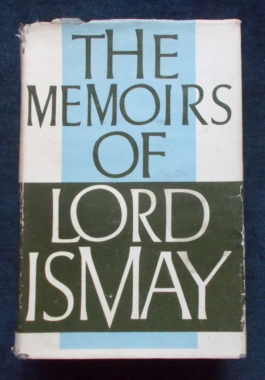 The appointment of Major-General H.L. Ismay to the Chiefs of Staff Committee was made on May 1st, 1940, when Churchill was First Lord of the Admiralty. On May 10th he succeeded Chamberlain as Prime Minister and Ismay's position at once became of the first importance. His functions were ill defined. He liked to call himself Churchill's "agent"; but he was very much more than that term usually implies. Out of his close association with the Prime Minister there grew a deep understanding and friendship. Accompanying him everywhere from blitzed areas in London to major conferences all over the world, or sharing with him his moments of relaxation after the heat of the day, Ismay had unique opportunities to observe the Colossus who was his master and his memoir paints a full portrait of Churchill. In 1925 Ismay was appointed Assistant Secretary to the Committee of Imperial defence. By the outbreak of the Second World War he was very experienced in committee work. The waging of total war in a democracy is a complex business: committees and conferences have to do their work, temperaments have to be reconciled and methods of implementing decisions arrived at. It is this aspect of the war covered by Lord Ismay. He was important as a peacemaker and mediator; there was no lack of potential friction between the Chiefs of Staff and their political superiors in World War II and the fact that this friction remained largely potential was largely due to Ismay. After his years in India, Somaliland and Whitehall and his work in World War II, he returned post-war to India as the personally invited advisor to the Viceroy, Lord Mountbatten, to contribute to the settlement of Partition, and after its successful conclusion Lord Ismay crowned his career of public service as the head of the North Atlantic Treaty Organization (NATO) where he strove to prevent a future war with the same energy as he had helped to win the past one.
The appointment of Major-General H.L. Ismay to the Chiefs of Staff Committee was made on May 1st, 1940, when Churchill was First Lord of the Admiralty. On May 10th he succeeded Chamberlain as Prime Minister and Ismay's position at once became of the first importance. His functions were ill defined. He liked to call himself Churchill's "agent"; but he was very much more than that term usually implies. Out of his close association with the Prime Minister there grew a deep understanding and friendship. Accompanying him everywhere from blitzed areas in London to major conferences all over the world, or sharing with him his moments of relaxation after the heat of the day, Ismay had unique opportunities to observe the Colossus who was his master and his memoir paints a full portrait of Churchill. In 1925 Ismay was appointed Assistant Secretary to the Committee of Imperial defence. By the outbreak of the Second World War he was very experienced in committee work. The waging of total war in a democracy is a complex business: committees and conferences have to do their work, temperaments have to be reconciled and methods of implementing decisions arrived at. It is this aspect of the war covered by Lord Ismay. He was important as a peacemaker and mediator; there was no lack of potential friction between the Chiefs of Staff and their political superiors in World War II and the fact that this friction remained largely potential was largely due to Ismay. After his years in India, Somaliland and Whitehall and his work in World War II, he returned post-war to India as the personally invited advisor to the Viceroy, Lord Mountbatten, to contribute to the settlement of Partition, and after its successful conclusion Lord Ismay crowned his career of public service as the head of the North Atlantic Treaty Organization (NATO) where he strove to prevent a future war with the same energy as he had helped to win the past one. -
 "Learn all you can about the German Army and one day you will be a valuable man to your country." These words were spoken to young Alexander Scotalnd by Major Wade, a British liaison officer in German West Africa in 1904. He never forgot those words. This book covers how much he learnt and how valuable were his services to his country. This young man served in the German Army - at the suggestion of the Germans - for the duration of the Hottentot Rebellion, thereby gaining an intimate knowledge of the organisation and strengths of the German military machine. He grew to know, by close contact, the habits, language and mental outlook of the German soldier. This knowledge was the basis of his achievements in espionage, interrogation and undercover work in two world wars. His reputation led to a strange meeting with Adolf Hitler in 1937, at the home of a mutual friend. His career reached its zenith in 1947 when - as Chief Officer of the War Crimes Investigation Unit, he played a decisive role in bringing Nazi war criminals to justice. Illustrated with black and white photographs.
"Learn all you can about the German Army and one day you will be a valuable man to your country." These words were spoken to young Alexander Scotalnd by Major Wade, a British liaison officer in German West Africa in 1904. He never forgot those words. This book covers how much he learnt and how valuable were his services to his country. This young man served in the German Army - at the suggestion of the Germans - for the duration of the Hottentot Rebellion, thereby gaining an intimate knowledge of the organisation and strengths of the German military machine. He grew to know, by close contact, the habits, language and mental outlook of the German soldier. This knowledge was the basis of his achievements in espionage, interrogation and undercover work in two world wars. His reputation led to a strange meeting with Adolf Hitler in 1937, at the home of a mutual friend. His career reached its zenith in 1947 when - as Chief Officer of the War Crimes Investigation Unit, he played a decisive role in bringing Nazi war criminals to justice. Illustrated with black and white photographs. -

 Australian Richard Hillary joined RAF Fighter Command’s 603 Squadron in July 1940, then based in Scotland and flying the new Supermarine Spitfire. On 27 August 1940 the squadron moved south to London, the epicentre of the Battle of Britain, and within a week Hillary had shot down five Messerschmitt 109s, becoming an ‘ace’. But on his last sortie he was shot out of the sky over Dungeness, the cockpit of his Spitfire became engulfed in flames and Hillary was grievously burned as he desperately tried to bale out. Hillary was soon to become the most famous patient of the RAF’s pioneering plastic surgeon, Archibald McIndoe, and member of his ‘Guinea Pig Club’. He would endure months of painful surgery in an attempt to repair the damage to his hands and face, and allow him to return to active duty. Originally published in 1942, just months before he died in a second crash, The Last Enemy recounts the struggles and successes of a young man in the Royal Air Force.
Australian Richard Hillary joined RAF Fighter Command’s 603 Squadron in July 1940, then based in Scotland and flying the new Supermarine Spitfire. On 27 August 1940 the squadron moved south to London, the epicentre of the Battle of Britain, and within a week Hillary had shot down five Messerschmitt 109s, becoming an ‘ace’. But on his last sortie he was shot out of the sky over Dungeness, the cockpit of his Spitfire became engulfed in flames and Hillary was grievously burned as he desperately tried to bale out. Hillary was soon to become the most famous patient of the RAF’s pioneering plastic surgeon, Archibald McIndoe, and member of his ‘Guinea Pig Club’. He would endure months of painful surgery in an attempt to repair the damage to his hands and face, and allow him to return to active duty. Originally published in 1942, just months before he died in a second crash, The Last Enemy recounts the struggles and successes of a young man in the Royal Air Force. -
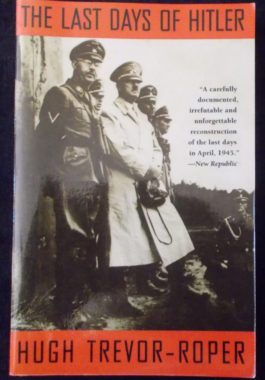 In September 1945, the fate of Hitler was a complete mystery. He had simply disappeared, missing for four months. The author, a British counter-intelligence officer, was given the task of solving this mystery. His brilliant piece of detective work not only proved that Hitler had killed himself in Berlin, but also produced one of the most fascinating history books ever written, telling the extraordinary story of those last days in the Berlin Bunker. Chapters include: Hitler and His Court; Hitler In Defeat; The Court in Defeat; Crisis and Decision; Siege of the Bunker. Et Tu, Brute. The Death of Hitler. Epilogue.
In September 1945, the fate of Hitler was a complete mystery. He had simply disappeared, missing for four months. The author, a British counter-intelligence officer, was given the task of solving this mystery. His brilliant piece of detective work not only proved that Hitler had killed himself in Berlin, but also produced one of the most fascinating history books ever written, telling the extraordinary story of those last days in the Berlin Bunker. Chapters include: Hitler and His Court; Hitler In Defeat; The Court in Defeat; Crisis and Decision; Siege of the Bunker. Et Tu, Brute. The Death of Hitler. Epilogue.




